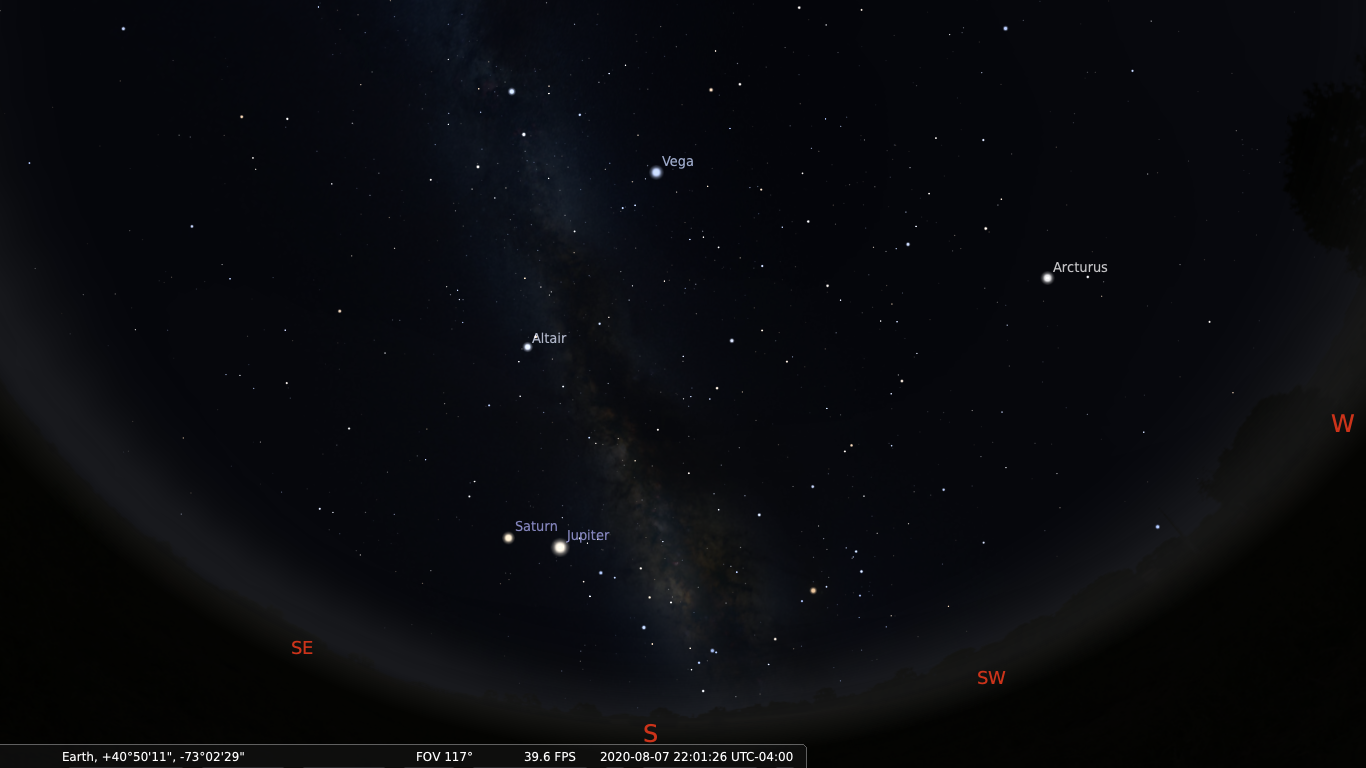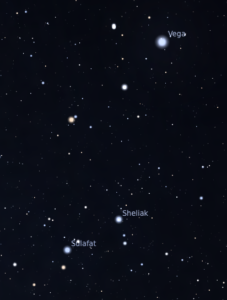
The field around Vega as imaged by the author. The “cross” is an artifact of the telescope’s secondary-mirror support system.
This is the second installment of our ten-part series on the brightest stars and, with it, we’re pleased to present Vega, the “Contact Star” (made famous by the feature-length Hollywood production of the same name, starring Jodie Foster and Matthew McConaughey). Vega, at 25 light-years distant, is the fifth brightest star in the sky and the third brightest star in the Northern Hemisphere after Sirius and Arcturus.
 Along with Deneb and Altair, early August finds Vega, one of the three stars that comprise the “Summer Triangle”, well-placed at the zenith at around 10:00 PM. A casual sweep of this part of the sky with a pair of binoculars will provide a stunning view, revealing thousands of stars set against the rich background of the Milky Way. The Summer Triangle is an asterism and not a constellation in its own right, a great triangle defined by Deneb, marking the tail of Cygnus, Vega and third, Altair the head of Aquila, the Eagle.
Along with Deneb and Altair, early August finds Vega, one of the three stars that comprise the “Summer Triangle”, well-placed at the zenith at around 10:00 PM. A casual sweep of this part of the sky with a pair of binoculars will provide a stunning view, revealing thousands of stars set against the rich background of the Milky Way. The Summer Triangle is an asterism and not a constellation in its own right, a great triangle defined by Deneb, marking the tail of Cygnus, Vega and third, Altair the head of Aquila, the Eagle.
In 13,000 years, as described in a recent article, Vega will be our “North Star” and then, 13,000 years hence, Polaris, again will be our “North Star”. Vega is the brightest star in Lyra, the harp or “Alpha Lyrae” according to the Bayer Designation (this designation identifies a star by a Greek or Latin letter in descending brightness order followed by the genitive form of its parent constellation’s Latin name).
Lyra, the Harp
According to Greek Lore and mythology, Orpheus, a legendary musician, poet and prophet, was transformed into a swan (Cygnus) after his murder and is said to have been placed in the sky next to his lyre, Lyra! According to the myth, Lyra is said to have been made from a tortoise shell and the first lyre ever produced. It has also been said that Orpheus’ music was so beautiful and enchanting that even inanimate objects such as trees and rocks were charmed and came to life. The remainder of Orpheus’ story is a classic example of a Greek Tragedy. It is said that he spent the last years of his life strumming his lyre while aimlessly wandering the Underworld, pining away for his lost love, Eurydice.
 The remainder of Lyra is composed of a handful of fainter stars, five in total and, although it is composed of faint stars, it is quite noteworthy as it contains an object famous to amateur and professional astronomers alike.
The remainder of Lyra is composed of a handful of fainter stars, five in total and, although it is composed of faint stars, it is quite noteworthy as it contains an object famous to amateur and professional astronomers alike.
Between the stars Sulafat and Sheliak, the two stars that mark the southern boundary of Lyra, is the famous “Ring Nebula” (see image below), a stellar remnant, the literal shell of a star that was once quite like our sun, a remnant that represents the last phase in the evolutionary life cycle of stars similar to our sun.
The summer sky is rich with bright stars and, most notably, the Milky Way. Although Lyra is comprised of faint stars with the exception of beautiful blue-white Vega, a scan of the area with binoculars is quite a treat and, if one is careful, patient and has good eyesight, as featured below, the famous “Ring Nebula” can be seen as a tiny “smoke ring”.

In a wide-field view closely representing the field of view afforded by a pair of binoculars, Messier 57 (M-57), the famous “Ring Nebula” can be seen as a small, red ring between Sulafat, to the left and Sheliak to the right. Imaged credit: the author
Like the sun, Vega is a stable, “Main Sequence” star, a star that is producing energy through thermonuclear fusion reactions in its core. Unlike the sun, however, it is much more luminous with over twice the sun’s mass and thus, if it replaced our sun, it would be 16x as bright in our sky! This scenario will be depicted in the accompanying, soon-to-be published video.
Being almost twice the effective temperature as the sun, it isn’t likely that Vega is now, or ever will be, host to any life-bearing planets. Stars in this luminosity class have a productive life-span of no more than 1.5 billion years, a factor of almost ten less than our sun, a star with a productive life-span of about 11 billion years. These stars are thus, too short-lived for life to emerge and thrive. It took 3.5 billion years for life to grow and evolve here to where it is today. A0V (the Morgan-Keenan spectral classification for Vega; the sun’s is G2V) stars such as Vega will have long-since evolved to become red-giants before life could ever get a foothold.
Next week’s installment will feature the red super-giant star Antares, the heart of Scorpius, the celestial scorpion.




One thought on “The Ten Brightest Stars (and where they are, with video) – 2. Vega”